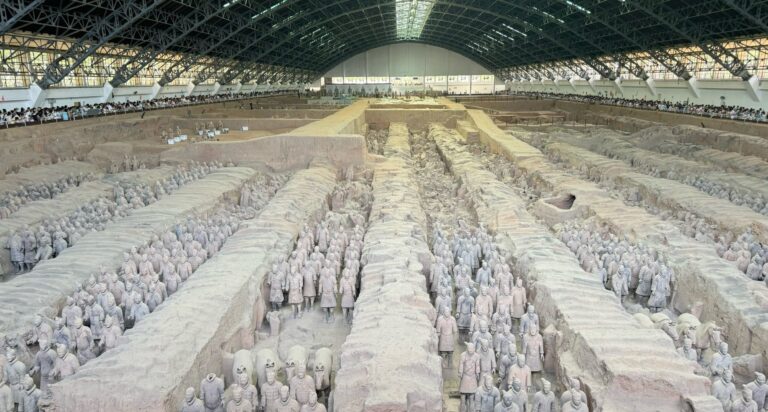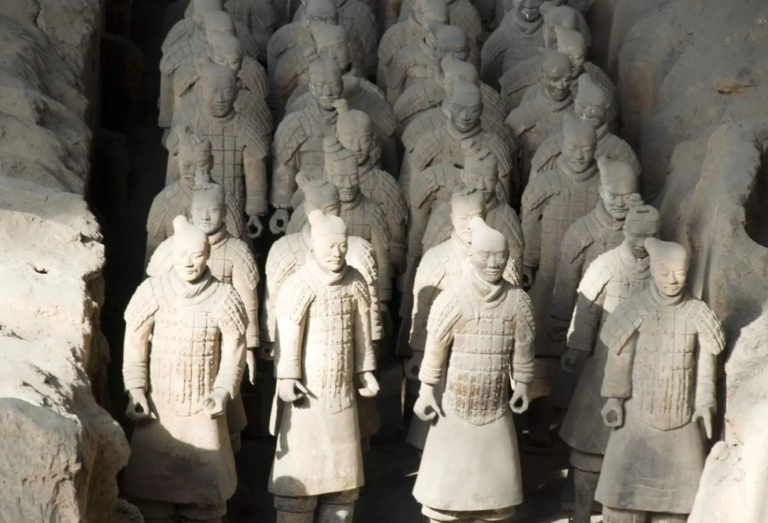What are 5 facts about the Terracotta Army?
the Terracotta Army:Five Cognitively Shattering Facts to Decode
Fact #1: It’s not an army, it’s Emperor Qin Shi Huang’s “digital empire”.
When American visitors stand in front of the Terracotta Army in Lintong, Xi’an, they see more than just clay statues. The more than 8,000 soldiers, horses and chariots, in fact, is the first emperor of Qin Shi Huang with binary thinking to build the “digital empire”: each terracotta warrior’s hairstyle, armor, posture have been coded design, through the combination of arrangements to achieve the digital management of military units. Kneeling terracotta warriors have the word “Gongjiang” engraved on their armor, which is not only a personal signature, but also an anti-counterfeiting mark of the Qin Dynasty’s “standardized production”. This wisdom of integrating individual characteristics into a collective order predates the Western Industrial Revolution by 2,000 years.

Fact 2: The Color Revolution Subverts Historical Perception
Most people think of the Terracotta Warriors as gray terra cotta, but the freshly unearthed terracotta warriors were clad in color: vermilion-red robes, peacock-blue armor, and pinkish-white skin. Archaeologists found gold dust particles with a diameter of only 0.1 millimeters in the pit of the terracotta warriors, proving that the Qin people had mastered nanoscale pigment processing technology. What’s more amazing is that each terracotta figurine painted pattern is a unique “identity code”, through chromatographic analysis can be traced back to its military service – this color management system, known as the ancient version of the “two-dimensional code”.
Fact 3: The underground army hides the prototype of “artificial intelligence”.
The arrangement of terracotta warriors implies early “machine learning” logic. By analyzing the layout of the terracotta pits, scientists found that there were systematic differences in the equipment of the soldiers in the front, flanks and rear guards: the front terracotta warriors were equipped with more arrowheads, and the shield thickness of the rear guard terracotta warriors was increased by 20%. This optimization of equipment based on battlefield positioning indicates that the Qin army had established a “data-driven” military decision-making model. Kneeling figurines have a higher stitch density than modern sneakers, proving that Qin military engineers had mastered ergonomics.
Fact 4: Unsolved Mysteries are More Shocking than Solved Problems
The excavated terracotta warriors account for only 1% of the entire burial area, and the latest remote sensing technology shows that there is also a complete array of sailor terracotta warriors and an orchestra of a hundred opera terracotta warriors buried under the ground. Scientists have detected abnormal levels of mercury in the soil of the terracotta pits, which is highly consistent with the “rivers of mercury” recorded in the Records of the Grand Historian. More mysteriously, all the terracotta warriors are facing east, while the location of the main coffin in the underground palace deviates from the central axis – a layout that may allude to Emperor Qin Shi Huang’s obsession with “east touring to seek immortality” during his lifetime.

Fact 5: The Terracotta Warriors are “repairing themselves”.
Modern technology is rewriting the story of the Terracotta Warriors. Through 3D printing technology, archaeologists have recovered complete kneeling terracotta warriors with colorful paintings; the application of nanomaterials has enabled fragile ceramics to “self-heal”. The most groundbreaking discovery is that the microbial population of the terracotta pits is able to break down pollutants without damaging the clay, a “natural protective mechanism” that provides a biotechnological solution for the protection of cultural relics. Just as digital modeling allowed the Terracotta Warriors to live forever in the metaverse, technology is giving these ancient warriors a new form of life.
Conclusion:
The value of the Terracotta Warriors lies not in the curiosity of whether they were cast by living men, but in their revelation as a mirror image of civilization. When the American audience gazed at these clay faces, what they saw was not only Qin Shi Huang’s desire for power, but also mankind’s eternal pursuit of transforming chaos into order. Just as the bronze swords in the terracotta pits are still shining after 2,000 years, the code of civilization carried by the Terracotta Warriors is blossoming into a brighter light than the emperor’s imagination, empowered by science and technology.






